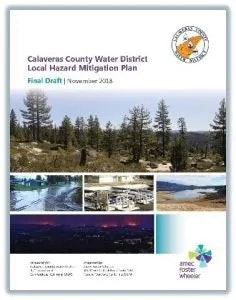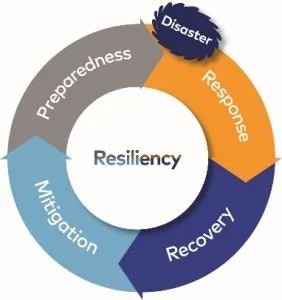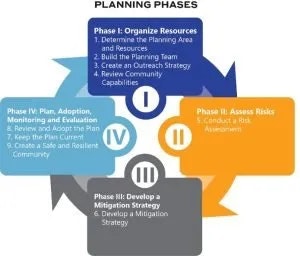Calaveras County Water District Local Hazard Mitigation Plan

Background
Calaveras County Water District (CCWD) is updating its 2018 Local Hazard Mitigation Plan (LHMP). This planning process involves the development of mitigation strategies designed to reduce risks and vulnerabilities posed by natural hazards. The plan must be updated and approved by the Federal Emergency Management Agency (FEMA) every five years to keep it current and to maintain eligibility for federal and state mitigation grant funding. The plan is currently being updated under the guidance of a Hazard Mitigation Planning Committee (HMPC).
What is Hazard Mitigation?
FEMA defines hazard mitigation as, “any sustained action taken to reduce or eliminate long-term risk to life and property from natural hazards.” Another way to understand hazard mitigation is the prevention component of the emergency management process.
Hazard mitigation is the first step in the disaster cycle and it is followed by preparedness, response, and recovery.

- Preparedness activities include emergency plans, trainings, drills, and exercises that individuals, communities and first responders participate in on an almost daily basis. These are things done to get ready for an emergency or disaster before it happens.
- Response is the short-term, emergency actions taken to address the immediate impacts of a hazard.
- Recovery is the longer-term process of restoring the community back to normal or pre-disaster conditions.
- Mitigation activities are cost-effective actions or projects that will reduce or eliminate impacts, for anticipated future events. Mitigation can reduce or eliminate the need for an emergency response and greatly reduce the recovery period.
Many types of mitigation actions are things done daily without much forethought such as purchasing insurance to protect a home investment or putting in gutters around a roof to better direct rain runoff. The same concepts apply to hazard mitigation planning. Mitigation planning is a process for county, city, and local governments or special districts to identify community-level policies, actions, and projects that will reduce the impacts of natural hazards.
Why is Hazard Mitigation Important?
Most people who live or work in CCWD’s service area have been affected by hazards in one way or another. Some of the hazards that can affect CCWD include earthquakes, flooding, wildfire, drought, high winds, electrical power shutoffs, and severe weather. The CCWD has been impacted by various severe storm and flooding events. The region has also experienced impacts from various wildfire events. In addition to these large events, there are also smaller, isolated weather events that cause localized facility and water infrastructure damage and losses that result in significant impacts to the CCWD’s ability to delivery water to customers. While these natural hazards cannot be prevented, regular updates to the CCWD’s LHMP will evaluate the potential for future damaging events and work toward long-term solutions and strategies to help mitigate their impacts in the future. This long-term mitigation strategy also reduces future disaster losses by breaking the repeated cycle of disaster damage and reconstruction. According to a report by the National Institute of Building Sciences, it is estimated that for every one dollar invested in hazard mitigation, an average of six dollars is saved on long-term disaster response and recovery.
Hazard mitigation plans are also required by law for municipalities and special districts to be eligible to apply for and receive pre- and post-disaster from FEMA’s Hazard Mitigation Assistance (HMA) funds. The Robert T. Stafford Disaster Relief and Emergency Assistance Act (Stafford Act) was signed into law in 1988 and provides the authority for federal disaster assistance activities, including preparedness and mitigation along with assistance for response and recovery. The Disaster Mitigation Act of 2000 (DMA 2000) amended the Stafford Act to reinforce the importance of mitigation planning and emphasize planning for disasters before they occur. DMA 2000 also established provisions and requirements for state, local, special districts, and Tribal Nations to closely coordinate mitigation planning and implementation efforts.
Project Benefits
Hazard mitigation can benefit a community by:
- Protecting public safety and preventing loss of life and injury.
- Reducing harm to existing and future development.
- Maintaining community continuity and strengthening the social connections that are essential for recovery.
- Preventing damage to the community’s unique economic, cultural, and environmental assets.
- Minimizing operational downtime and accelerating recovery after disasters.
- Reducing the costs of disaster response and recovery and the exposure to risk.
- Implementing capital improvements, infrastructure protection, open space preservation, and supporting economic resiliency.
Additionally, CCWD will benefit from this planning project by:
- Ensuring continued eligibility for FEMA HMA funds.
- Increasing public awareness of community vulnerabilities and supporting actions that reduce losses from future disasters.
- Ensuring policies, programs, and goals are compatible with reducing vulnerability to all hazards.
- Building partnerships with diverse stakeholders and increasing opportunities to leverage data and resources.
- Expanding the understanding of potential risk reduction measures to include local plans and regulations; structure and infrastructure projects; natural systems protection; education and awareness programs; and other tools.
- Informing the development, prioritization, and implementation of mitigation projects.
Plan Development Process
CCWD’s 2018 LHMP will be updated following FEMA’s 4-phase and 9-step planning process, with professional planning assistance from WSP USA (WSP). WSP will facilitate the planning process, collect necessary natural hazard data, and prepare the risk assessment and LHMP document. The HMPC will be organized, and will meet regularly, working through varying levels of review, and revision of the following elements of the LHMP:

- Identify hazards that may impact or have impacted CCWD;
- Profiles of hazard events;
- Assessment of the vulnerability to those hazards;
- Assessment of the CCWD’s capabilities to mitigate the hazards;
- Mitigation goals;
- Specific mitigation actions and projects;
- Implementation strategy for the plan;
- Plan maintenance and update process;
- Plan approval and adoption.
The HMPC will include staff representatives and board members from the CCWD. Stakeholders will include representatives from federal and state agencies, and local municipalities, educational institutions, businesses, and organizations that represent underserved communities.
The planning process began with a kick-off for the first HMPC meeting in March 2023. The second HMPC meeting will be scheduled in May 2023 and the third HMPC meeting will be scheduled in June 2023. The LHMP will be developed in July 2023, with a draft for public review anticipated by August 2023.
How Can You Get Involved?
Members of the public and CCWD customers have a very important role in this process. The HMPC regards broad public participation in the planning process as an essential strategy for developing a plan that will be effective, supported by water customers within the CCWD, and ultimately implemented. The process will provide a range of opportunities for the CCWD and its customers, public officials, and stakeholder groups to participate and provide input on the development of the LHMP update. Interested stakeholders can visit the CCWD’s LHMP webpage at ccwd.org for updates on the process and availability of the Public Review Draft LHMP.
For more information on CCWD’s LHMP or the planning process, please contact:
